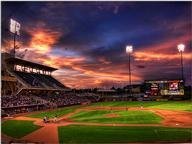Quiz Answer Key and Fun Facts
1. Few major league prospects received more attention than Sidd Finch, an unbelievable talent scouted by the New York Mets in 1985. Finch first received national attention in a "Sports Illustrated" (SI) profile in that year's baseball preview. What celebrated author and sports journalist wrote this piece?
2. Finch's main selling point as a pitcher was the sheer speed of his fastball, which he called the "perfect pitch". In his minor-league tryout, the fireballer's money pitch was clocked at a speed no one had ever seen before. Taking into account that the fastest pitches ever clocked in major league competition came in at 103 miles per hour, how fast was Finch's heater?
3. Though he could obviously throw the ball hard, Finch also possessed a dazzling repertoire of breaking balls that, in the words of one Mets scout, "rivaled Bert Blyleven's".
4. Among the more astonishing aspects of Sidd Finch's life was that, as far as anyone could tell, he had played no organized amateur baseball before his professional tryout! He had attended college, but to the best of anyone's recollection he had expressed NO interest in playing varsity baseball. What prestigious institution did Finch attend?
5. Following his tryout, Finch was evaluated, for want of a better word, by the Mets' veteran pitching coach. This was a daunting assignment, as Finch was only attending training camp on the conditions that he conduct no training drills with the rest of the team and that he pitch only under cover of a canvas enclosure away from the prying eyes of the media, as well as the rest of the Mets! Who was the pitching coach who found himself baffled by Finch's pitching mechanics and personal philosophy?
6. To deal with this remarkable prospect, the Mets assigned Finch a personal catcher, a strongly-built backup from the University of Arkansas who had been in the organization since 1982. Who was the brave soul who endured Finch's searing velocity?
7. Apart from Finch's nearly incomprehensible lifestyle (his personal possessions seemed to amount to little more than a shepherd's crook, a small rug, a bowl, and what clothing would fit in his napsack), a major problem the Mets faced was trying to persuade the hurler to commit to baseball; as of the Sports Illustrated article, he remained technically unsigned on the eve of opening day! A contributing factor to Finch's indecision was his ability to play classical music at the virtuoso level. The artistic director for the New York Philomusica was quoted as saying that Finch could have his pick of orchestral assignments. What was Finch's instrument?
8. Another factor contributing to Finch's hesitance to commit to the Mets was his devotion to a faith that eschewed the greed and competitiveness endemic to professional baseball. Ironically enough, Finch's religious practice may have precipitated his development of a blazing fastball. What was Finch's spiritual calling?
9. As of the "Sports Illustrated" article's compilation, Finch's most extensive workout had been throwing his "perfect pitch" past three other outstanding Met prospects, none of whom had even bothered to take a cut at the phenom's heater at top speed. One of them, a future three-time all-star and leadoff man for the Mets' 1986 World Championship team, swore that Finch's fastball went a great deal faster than the team's pitching machine at that device's top velocity. What was his name?
10. Though all the journalistic hype made Finch seem like a sure thing, you will not find Finch's name in any of the various baseball encyclopedias; he never appeared in the majors. What spoiled the way for this seemingly unhittable pitcher?
Source: Author
stuthehistoryguy
This quiz was reviewed by FunTrivia editor
Nightmare before going online.
Any errors found in FunTrivia content are routinely corrected through our feedback system.
